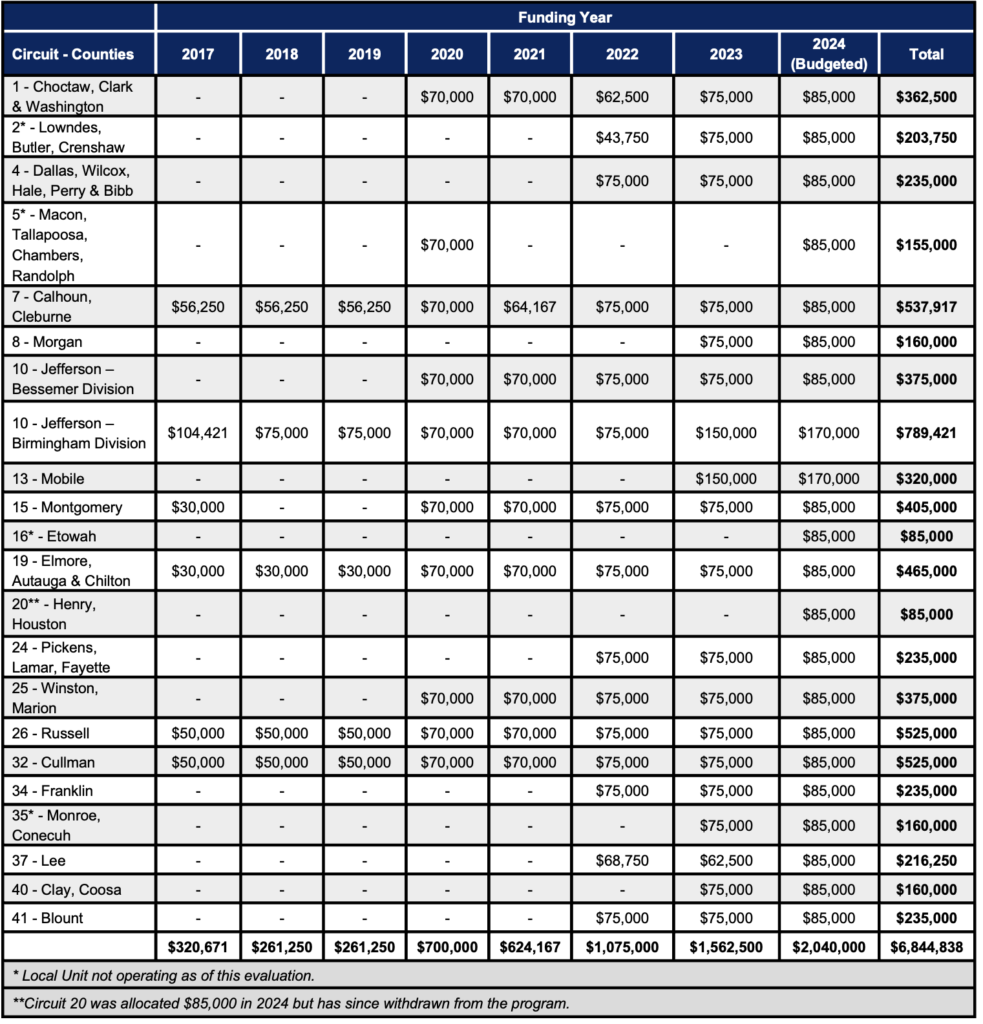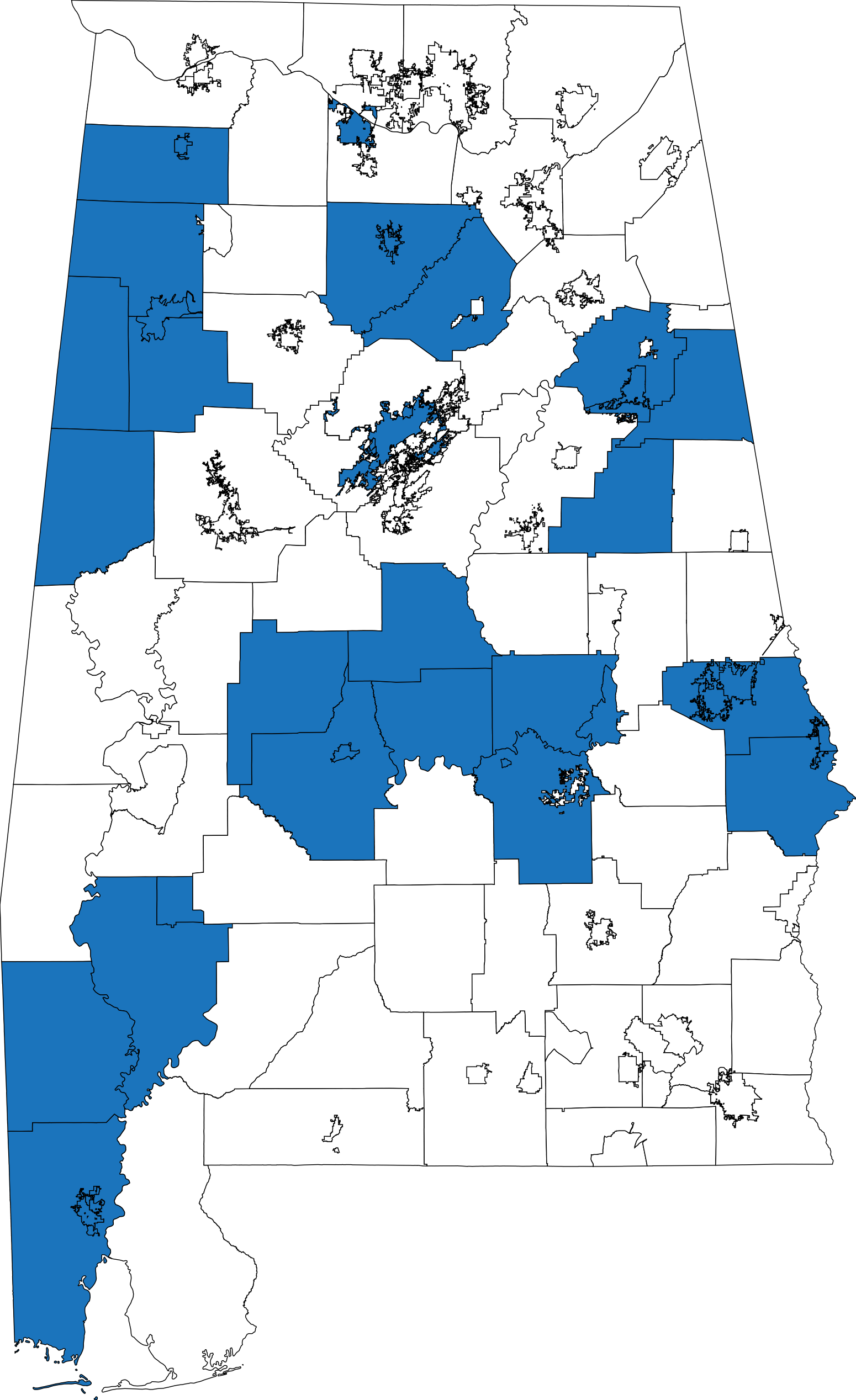Helping Families Initiative
A Program EvaluationReport Summary
Conclusion:
Key Findings:
-
-
There is a fundamental lack of accountability within the program that impacts fidelity, effectiveness, and efficiency.
-
HFI’s program is not implemented as designed. In each of the six steps, there are serious inconsistencies of operations. No locality operates with full fidelity to the model.
-
Outcome data is not collected. Output data that is collected are self-reported, unverified, and inaccurate.
-
HFI’s current funding model is not diverse, adaptable, or equitable. It is does not consider the status or operations, number of students served, or availability of local resources.
-
Half of the current localities have amassed a surplus of $830,000 in state funds.
-
HFI’s administrative costs have averaged 29% since receiving state funding.
-
The State Support Team has retained a surplus of $625,121. The budgeted use of these funds is conditioned on increased funding from the state. This further illustrates the inefficient operations of the program.
-
Recommendations:
-
-
Establish performance metrics that align with intended outcomes.
-
Implement rigorous tracking, monitoring, and compliance within HFI’s case management system.
-
Ensure consistent operations by establishing uniform standard operating procedures.
-
Work with school systems to adopt a universal Code of Conduct.
-
Create a more equitable, efficient, and accountable funding model.
-
Set a startup funding amount that is contingent on operations.
-
Require monthly itemized invoicing that includes all HFI related expenditures.
-
Cap HFI administrative expenses at 15% and accumulated surplus of state funds to 10% of annual appropriations.
-
Conduct an impact evaluation to study HFI’s impact on intended outcomes.
-
Discontinue expansion efforts to new circuits until an impact evaluation is conducted.
-
Summary of Recommendations
The Governor and the legislature should consider:
- Conducting an impact evaluation to study the impact of HFI on intended outcomes.
- Discontinuing expansion efforts to new circuits until an impact evaluation is completed.
- Capping administrative expenses for both Volunteers of America Southeast and the State Support Team at 15% collectively.
- Capping Volunteers of America Southeast and the State Support Team’s total accumulated surplus of state funds at 10% of the annual appropriation.
- Creating a universal code of conduct for attendance and behavior in PreK-12 schools.
The Helping Families Initiative should:
- Work with school systems to adopt a universal code of conduct.
- Upgrade the case management system to include tracking and monitoring of program components.
- Develop standard operating procedures for the case management system and require Local Units to use the system in accordance with the standard operating procedures.
- Create a structure of trainings and retraining for noncompliant Local Units to enforce compliance.
- Discontinue funding for repeated non-compliance.
- Establish performance metrics that align with intended outcomes.
- Create rigorous participant tracking, monitoring, and compliance within the case management system.
- Establish quality control procedures for case management use.
- Cap circuit funding at the base amount until a targeted funding model is created.
- Create a targeted funding model that considers:
- Historical case load.
- Students enrolled in participating school systems.
- Number of Local Unit employees (FTEs).
- Capacity and availability for local investment.
- Require monthly itemized invoicing that includes all HFI related expenditures, regardless of revenue source.
- Set a startup funding amount where additional funding is not provided until Local Units have invoiced HFI for the full startup amount.
Helping Families Initiative
Chronic absenteeism[1] rates have been on the rise nationwide predating the pandemic but have risen at an even more exponential rate due to the impacts of COVID-19 on school attendance. In the 2021-2022 school year, Alabama was among the best states (20th percentile nationally) in terms of chronic absenteeism rates. With campaigns such as Attendance Works,[i] chronic absenteeism has been a growing topic of interest in the state of Alabama[ii] as well as the nation. Attendance is cited to have a significant impact on student performance and graduation rates, among other things.[iii]
The Helping Families Initiative (HFI) was created in 2003 by Mobile County’s District Attorney who saw a need for early intervention among students who exhibit behavioral issues. Over time, chronic absenteeism became another focus of the program’s intervention. The program’s current design is to connect three existing tiers of support: district attorneys, school systems, and community resources, to create an individualized approach to achieve the following outcomes:
- Improved attendance in school.
- Improved behavior in school.
- Improved grades.
- Improved safety and security of students, families, and communities.
- Improved delivery of comprehensive, cooperative, and coordinated services.
- Improved values of existing tax and charitable dollars.
To distinguish the different terms that are associated with the HFI program, the following are defined as:
- Circuit – refers to judicial circuits that operate under a district attorney.
- HFI – refers to the program as a whole. This all-encompassing term reflects the program, statewide operations, the State Support Team, Local Units, and Volunteers of America Southeast when used.
- Local Unit – refers to the local HFI offices which are housed in the district attorney’s office and operate the program in a specific circuit.
- State Support Team – refers to the seven-member team that provides training and operational support to all Local Units.
- Volunteers of America Southeast – refers to the non-profit organization of which Helping Families Initiative is a program.
The 17 Local Units currently serve 44 school systems throughout the state.
Purpose and Scope of the Evaluation
HFI receives funding from the state through Education Trust Fund appropriations to administer the program with the intent to reduce chronic absenteeism and improve student behavior across the state. The purpose of this evaluation is to analyze the following:
- Are Local Units operating with fidelity to the model?
- Is the program effective at achieving intended outcomes?
- Is the program efficiently using state resources?
Through the fieldwork phase of this evaluation, it was revealed that a lack of accountability is a serious issue with this program. Therefore, each section within this report will highlight issues with accountability through subsections aligning accountability with fidelity, effectiveness, and efficiency.
Summary of Recommendations
The Governor and the legislature should consider:
- Conducting an impact evaluation to study the impact of HFI on intended outcomes.
- Discontinuing expansion efforts to new circuits until an impact evaluation is completed.
- Capping administrative expenses for both Volunteers of America Southeast and the State Support Team at 15% collectively.
- Capping Volunteers of America Southeast and the State Support Team’s total accumulated surplus of state funds at 10% of the annual appropriation.
- Creating a universal code of conduct for attendance and behavior in PreK-12 schools.
The Helping Families Initiative should:
- Work with school systems to adopt a universal code of conduct.
- Upgrade the case management system to include tracking and monitoring of program components.
- Develop standard operating procedures for the case management system and require Local Units to use the system in accordance with the standard operating procedures.
- Create a structure of trainings and retraining for noncompliant Local Units to enforce compliance.
- Discontinue funding for repeated non-compliance.
- Establish performance metrics that align with intended outcomes.
- Create rigorous participant tracking, monitoring, and compliance within the case management system.
- Establish quality control procedures for case management use.
- Cap circuit funding at the base amount until a targeted funding model is created.
- Create a targeted funding model that considers:
- Historical case load.
- Students enrolled in participating school systems.
- Number of Local Unit employees (FTEs).
- Capacity and availability for local investment.
- Require monthly itemized invoicing that includes all HFI related expenditures, regardless of revenue source.
- Set a startup funding amount where additional funding is not provided until Local Units have invoiced HFI for the full startup amount.
Overview of the Helping Families Initiative
Although the program began in 2003, it did not start receiving funding from the state until FY17. Predating state funding, there were only two Local Units in operation. There has since been a 558% increase in funding that has coincided with HFI’s expansion efforts. A total of 17 Local Units were in operation in FY23. Two more Local Units received funding but were not in operation. HFI also has agreements to expand to two additional Local Units (21 total). During the 2024 legislative session, HFI requested funding of $10,320,000 for FY25. See Figure 1.
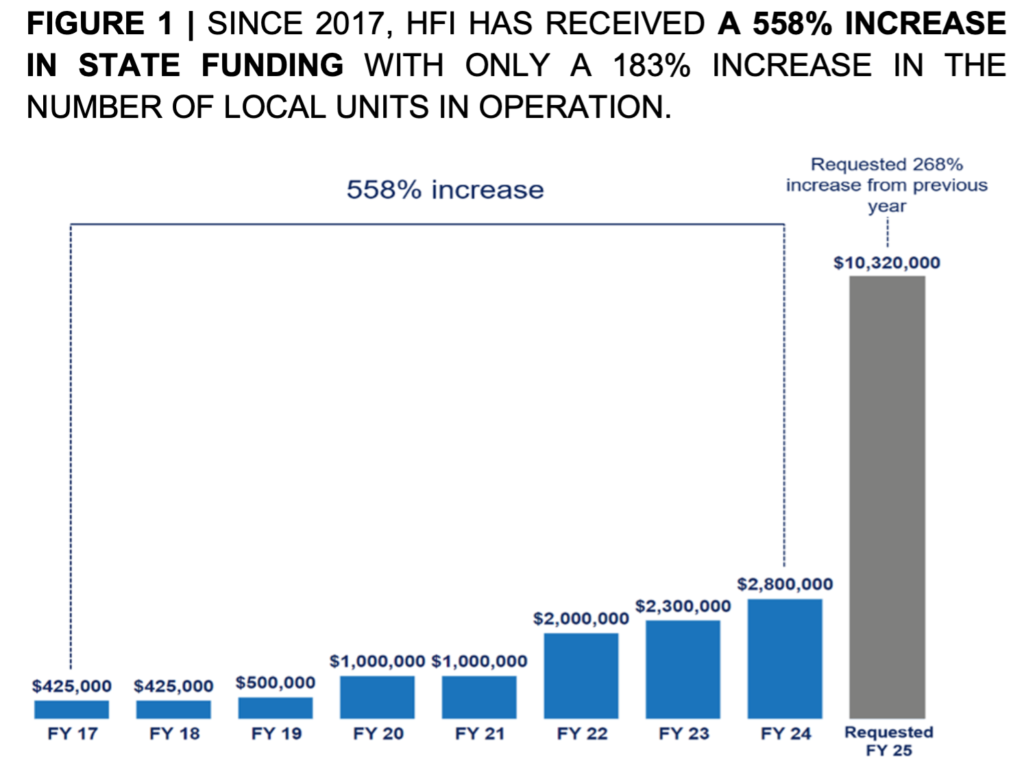
HFI is currently operating under Volunteers of America Southeast. The program has a State Support Team that oversees the program’s operations and trainings. Under the advisement of the State Support Team, each Local Unit is created through a partnership with HFI, district attorney’s office, local school systems, and community partners. The Local Units are employees of the district attorney’s office[2] and receive allocations from HFI’s state funding.
Detailed Findings and Recommendations
Fidelity | Are Local Units operating with fidelity to the model?
Programs that are implemented to fidelity typically demonstrate more effectiveness. Without ensuring fidelity, it is impossible to determine if any perceived effectiveness is due to the elements of the program rather than the variance in operations.[iv] The HFI model is designed to go through a multi-step process which includes:- A Triggering Event.
- Engagement.
- Assign Case Officer and Conduct Family Assessment.
- Interagency Team: Individualized Intervention Plan.
- Referrals.
- Follow-up Family Assessment.
Fidelity
“The degree of which programs are implemented as intended by the program developers. It is only by making an appropriate evaluation of fidelity, with which an intervention has been implemented that a viable assessment can be made of its contribution to outcomes. i.e., its effect on performance.” (Carol et.al, 2007, p. 1)
A Triggering Event
HFI defines this triggering event as a certain number of unexcused absences or a certain behavior violation. However, HFI does not define what number of absences or violations constitute a need for early intervention. The triggering event is defined differently through each school system’s published code of conduct. Triggering events for truancy range from three unexcused absences to ten unexcused absences. Because the triggering event is set by each school system, the trigger may differ even within the same judicial circuit. For example, one Local Unit is currently serving five different school systems. Two of those school systems use five unexcused absences, while the other three use seven unexcused absences as the triggering event. Because there is not a uniform triggering event, Local Units cannot stage early intervention with families at the same point within the same circuit, much less statewide.
Engagement
The timeline at which HFI becomes involved is dependent on each school system’s code of conduct, causing disparities in the timeline of engagement. The inconsistencies in the timeline are further exasperated by other intervention efforts made before students are referred to HFI. Other intervention efforts include school system interventions and preexisting, early warning truancy programs. Some school systems use HFI as the first intervention effort, while others use HFI as the last effort before filing a petition against the student or guardians. It should be noted that many cases are resolved after a letter is sent from the district attorney’s office. Varied times of engagement across the state create inconsistencies which limit fidelity.
Non-participating District Attorneys
ACES interviewed district attorneys who are not currently participating in HFI. One of the top reasons for non-participation was existing interventions already in place, meaning the program would become duplicative in their circuit.
Assign Case Officer and Conduct Family Assessment
Completing a full family assessment, when necessary, was cited as an essential component to the HFI model, but this rarely occurs. Case officers are trained to use the North Carolina Family Assessment Scale to assess and help identify possible intervention efforts. Case officers’ use of the assessment varies drastically. In some cases, the case officers do not fully utilize the tool, while others do not use the tool at all. Incomplete or partial use of the family assessment limits the usefulness of the tool therefore impacting both the fidelity and effectiveness of the program.
Interagency Team: Individualized Intervention Plan
The interagency team is cited as a key part of the structured HFI process, designed to bring in community partners as an essential stakeholder. Interagency teams are meant to work in conjunction with the team lead and case officer to create an individualized intervention plan. Utilizing a family assessment and the interagency team, the individualized intervention plan addresses key areas of intervention for students and families. There are currently Local Units who have been operating for multiple years who have not formed or do not utilize an interagency team to help inform the individualized intervention plan. Over half of current Local Units’ interagency teams do not operate as intended or at all. Although a critical component of the program, the proper use of the interagency team has been foregone.
Referrals
Without proper use of the family assessment tool and utilization of the interagency team, referrals can become subjective. Referrals are the component of the HFI program specifically designed to address the individual needs of participants and are used by almost every Local Unit. Local Units refer individuals and families to services and follow-up with those referrals to ensure they are utilized. However, it is important to note that they do not provide services beyond case management. The non-adherence to the other program components creates potential discrepancies in the selection and effectiveness of referrals.
Follow-up Family Assessment
Case officers and team leads should complete the family assessment by performing a follow-up assessment. The purpose of the follow-up assessment is to evaluate the change in a family’s scores since their initial assessment and if there is an additional need for services. ACES found only one Local Unit reported making significant efforts to complete the full family assessment, which prescribes a pretest and posttest. Without the full completion of the family assessment, it cannot be determined if the program is reducing the associated risk factors for participants.
Local Units are not accountable to the State Support Team. The Local Units can deviate from the model without consequences from the State Support Team. Under HFI’s design, team leads and case officers are employed by and responsible to the district attorney within their respective circuit. However, district attorneys are not typically involved in the training of case officers and team leads or the day-to-day operations. Because the district attorneys and the State Support Team are not involved in the local operations, discrepancies in program fidelity may not be discovered or corrected.
There are structural flaws with expansion of the program. Local Units are housed within a judicial circuit’s district attorney’s office. The stated reasoning for this organizational structure is two-fold:
- The program model is built on the premise of connecting judicial institutions with schools and community resources to address the issues.
- Under Alabama law, “[t]he district attorney shall vigorously enforce [the written policy on school behavior adopted by the local board of education] to ensure proper conduct and required attendance by any child enrolled in public school.”[vi]
This means the HFI program is operated from within the division responsible for enforcement instead of the division responsible for operating, i.e., the school system.
Because individual school systems set their own policies, recruiting district attorneys to create and operate a policy leads to inconsistent delivery across the state.This structure traces its roots back to the program’s origins, where members of the current State Support Team were able to develop a program with support from the local school system which was reportedly successful.[vii] However, this structure creates a design flaw in the expansion and deployment of the program to new localities as a model. As previously discussed, interviews with participating school systems revealed wholesale inconsistencies with the triggering event and beginning of engagement with Local Units. Further evidence of the structural flaw can be seen in the number of non-participating school systems within HFI circuits. See Where HFI Operates.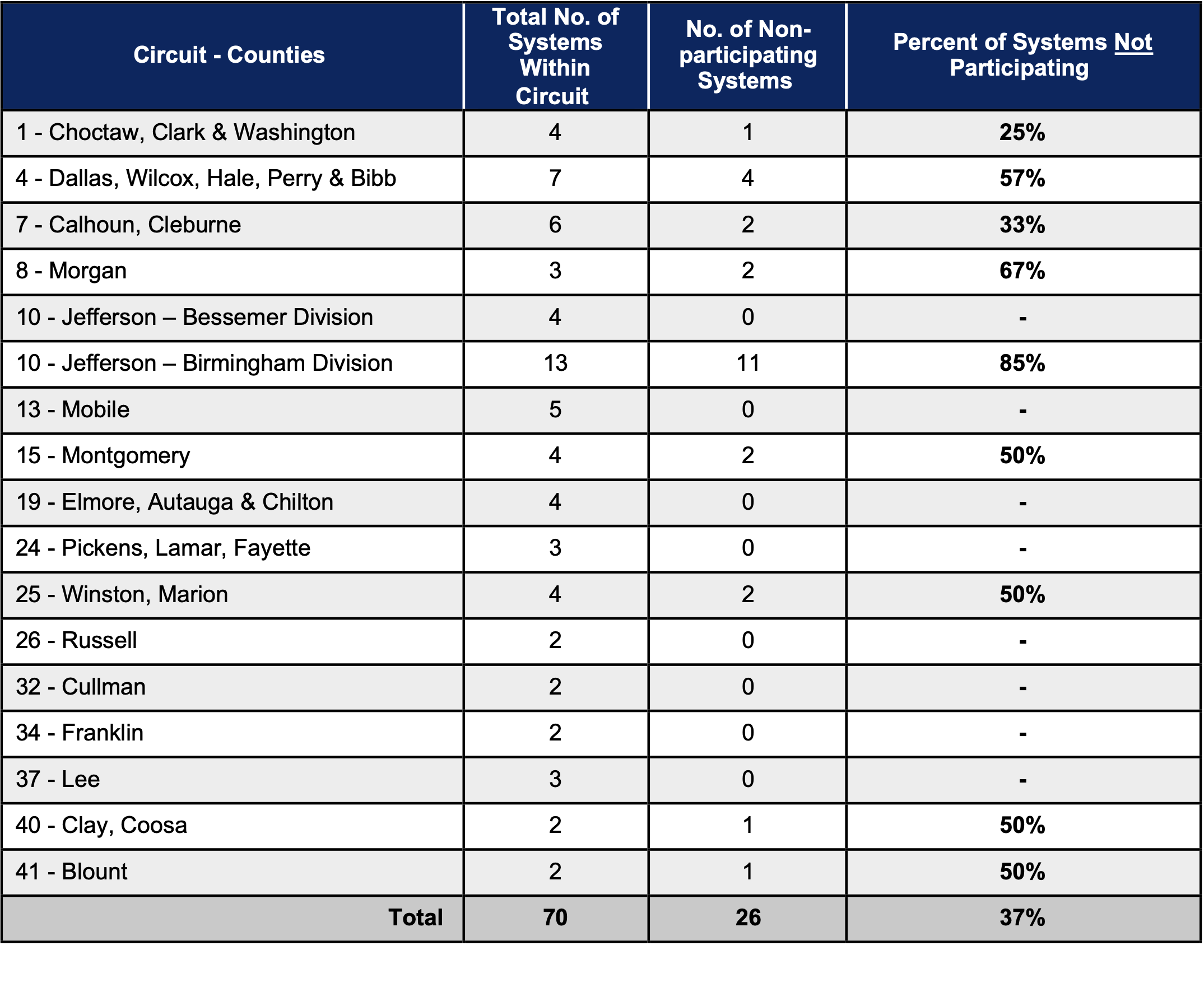
Accountability through the Lens of Fidelity
Letter from the District Attorney’s Office
Although there are structural flaws with where the program is located, school systems noted that letters and engagements from the District Attorney’s offices held more weight with families and students.
Non-participating School Systems
HFI reports they are in 18 judicial circuits, but the program only has operating partnerships with 44 school systems out of the 70 school systems in those participating circuits.
Recommendations
To create accountability and fidelity within the program, align programmatic standard operating procedures to the model across jurisdictions. The Helping Families Initiative should:
- Work with school systems to adopt a universal code of conduct.
- Upgrade the case management system to include tracking and monitoring of program components.
- Develop standard operating procedures for the case management system and require Local Units to use the system in accordance with the standard operating procedures.
- Create a structure of trainings and retraining for noncompliant Local Units to enforce compliance.
- Discontinue funding for repeated non-compliance.
Effectiveness | Is the program effective at achieving intended outcomes?
While ACES made extensive efforts to determine the program’s effectiveness, the lack of fidelity to the program across the state means effectiveness, or lack thereof, cannot be attributable to the HFI program. Effectiveness should be tied to measurable outcomes. While HFI does have stated outcomes, they cannot be measured with currently collected data.
- Letters sent.
- Active cases.
- Fulfilled individualized intervention plans.
- Interagency team meetings.
- Community referrals by type.
Data Collection
HFI has a case-management software that is not regularly used by Local Units. Since they do not use the software, there is no central repository for the State Support Team to monitor.
During Local Unit interviews, team leads and case officers cited name recognition as their primary identifier for tracking students who have previously been part of the program.
Analysis revealed metrics contained in the State Support Team’s annual reports – which is compiled from the Local Units’ monthly reports – do not align with the reported metrics from Local Units. During a routine quality assurance check,
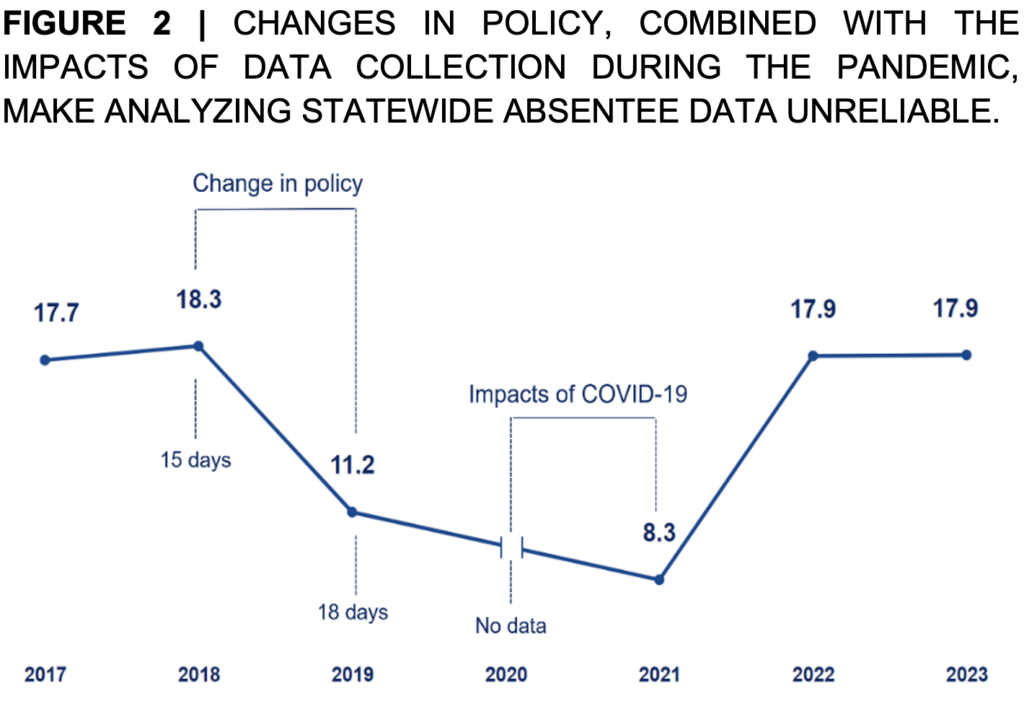
Additionally, the COVID-19 pandemic disrupted chronic absenteeism data collection entirely for the 2019-2020 school year. The unusual conditions of the pandemic caused attendance data to be difficult to track the following school year as well, impacting chronic absenteeism rates for the 2020-2021 school year. Because of these variables, chronic absenteeism rates may appear inflated or deflated at various points making analysis of this data unreliable. The current use of chronic absenteeism and self-reported, inaccurate, and unverified monthly reporting is misleading.[4]
Accountability through the Lens of Effectiveness
Throughout HFI’s attempts to measure performance through monthly reporting, there is a severe lack of accountability both for the Local Units and for the State Support Team. Local Units are not obligated to fill out monthly reports accurately or in their entirety. Compounding the issue, the State Support Team’s annual reports lack quality assurance. There are not currently systems in place to address either issue with the data. Any use of chronic absenteeism rates and HFI monthly reporting is misleading due to this fundamental lack of accountability.
Recommendations
To evaluate future effectiveness, collect meaningful and outcome-driven data points. The Helping Families Initiative should:
- Establish performance metrics that align with intended outcomes.
- Create rigorous participant tracking, monitoring, and compliance within the case management system.
- Establish a quality control process for case management use.
Efficiency | Is the program efficiently using state resources?
Although Local Units receive support from sources other than the state, a nonadaptive funding model, the lack of oversight and accountability, and rising administrative costs are contributing factors to the inefficiencies of the program.
HFI generates significant local investment in the program. The current HFI funding formula allocates $85,000[5] to a Local Unit for the purpose of funding one full-time case officer, regardless of the number of FTEs recommended to fully staff the unit. Local Units wanting to expand the program beyond the single case officer are seeking funding from the community by way of county commissions, local boards of education, federal Title IV funding, and non-profit organizations. Half of the Local Units funded in FY23 received substantial investments from sources outside of HFI state funding.
HFI Funding Model
HFI’s current funding model is neither diverse nor adaptable. Since being funded by the state, HFI has allocated a base amount per Local Unit, with very few exceptions. See HFI Funding by Circuit. 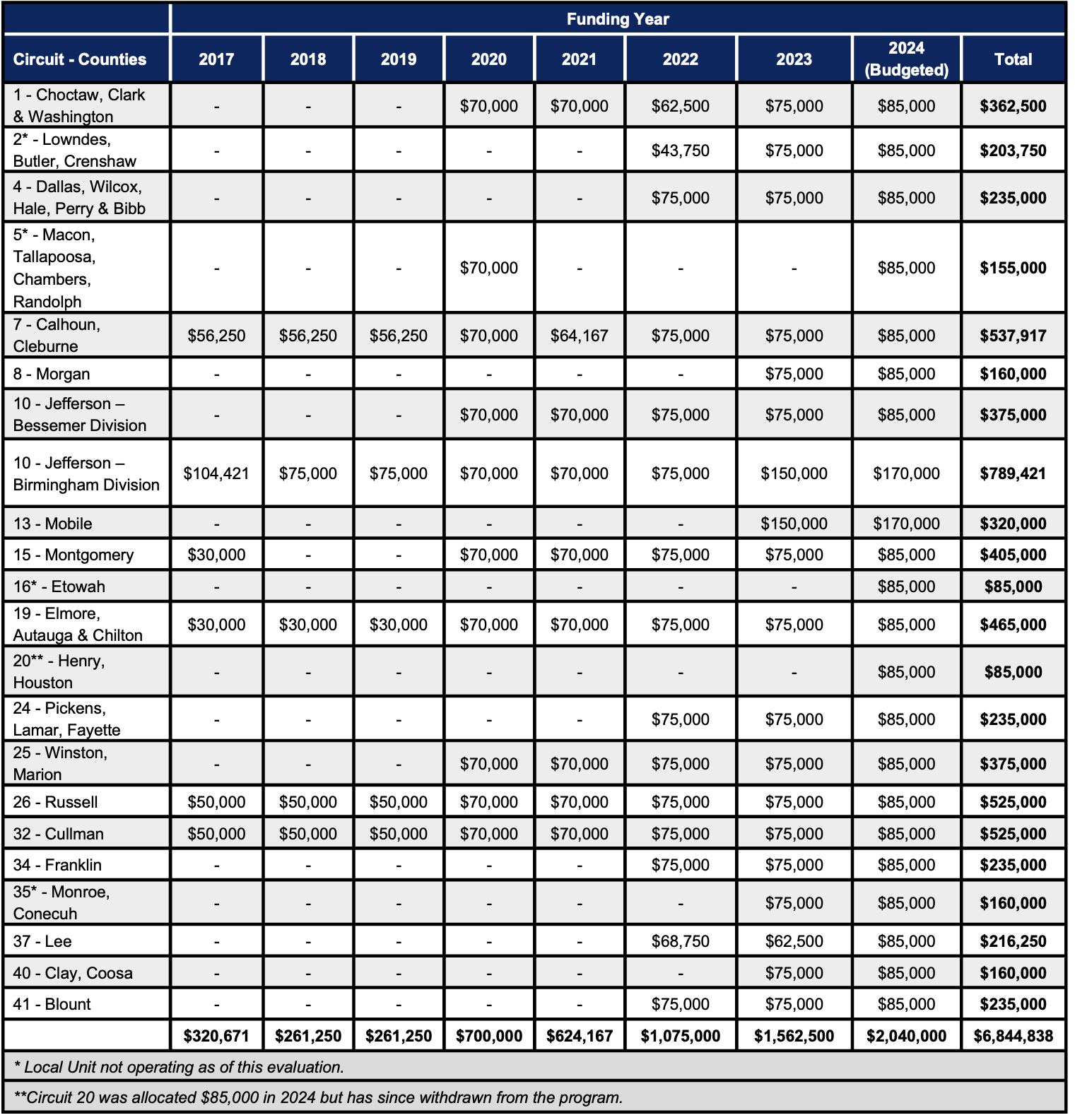 The base-funding amount is designed to cover costs associated with one case officer and does not consider operational status or the financial, personnel, or resource needs of a Local Unit. One example of this discrepancy can be found in Circuit 10 (Birmingham Division). While this Local Unit could potentially operate in school systems with an enrollment exceeding 90,000 students, they currently only serve 22.5% of that population (21,234 students). This circuit has also recruited significant local investment and has an average annual surplus of over $97,000. Despite these factors, Circuit 10 (Birmingham Division) is one of only two Local Units to receive or budgeted to receive more than the HFI base-funding amount in FY23 and FY24.
The base-funding amount is designed to cover costs associated with one case officer and does not consider operational status or the financial, personnel, or resource needs of a Local Unit. One example of this discrepancy can be found in Circuit 10 (Birmingham Division). While this Local Unit could potentially operate in school systems with an enrollment exceeding 90,000 students, they currently only serve 22.5% of that population (21,234 students). This circuit has also recruited significant local investment and has an average annual surplus of over $97,000. Despite these factors, Circuit 10 (Birmingham Division) is one of only two Local Units to receive or budgeted to receive more than the HFI base-funding amount in FY23 and FY24.
In contrast, Circuit 19 currently serves all 29,000 possible students enrolled and has reported the need for additional funds to maintain current staffing. Circuit 19 has never received additional HFI funding beyond the base amount. The flat-rate funding is attributable, in part, to the efforts of HFI that are focused on providing startup funds[6] related to expansion and less on implementation and development of new and existing Local Units. The current funding model is not diverse or adaptive to the state of operations as well as the number of school systems participating in the program.
The proposed funding formula is not based on needs or operational status. The HFI recommended funding model is based on jurisdictional student population with additional consideration for circuits covering multiple counties. The model recommends:[ix]
- One case officer per 6,000 students enrolled in the jurisdiction.
- One case officer per county regardless of the number of students enrolled in the jurisdiction.
- Supervisory personnel for the Local Units that have more than six case officers (1:6).
Continuous funding for Local Units is not contingent on operations. Upon signing an MOU with Volunteers of America Southeast, a Local Unit can receive startup funding. The time between receiving startup funding and fully operating the program varies. Some units did not operate for multiple years after receiving startup funds. Despite not being in operation, these units continued to receive full base-funding in subsequent years.
Of the Local Units funded in FY23:
- Three received funding of $150,000 over two years while still not hiring a case officer until late in FY23.
- One received $118,750 of funding over two years without ever hiring a case officer.
- One received the full $75,000 startup funding without ever hiring a case officer.
These five Local Units (28% of all Local Units) are budgeted to receive the full $85,000 funding in FY24. Collectively, these Local Units have funding surpluses totaling over $538,000 through FY23 with an additional $745,000 requested for FY25.
Non-Operational Local Units
In at least two instances, the Local Unit received the full base-funding without hiring a case officer in the first year. Moreover, full funding continued in the second year without a full-time case officer on staff for the entire year or at all.

The program operating under the Volunteers of America Southeast umbrella is a significant driver of administrative costs. Starting in 2022, Volunteers of America Southeast received an increased share of the total state appropriation which coincided with a significant increase in funding. The current share is a fixed rate (10.5%), regardless of increases in funding from the state. Based on the fixed rate and the FY25 funding request, administrative costs of Volunteers of America Southeast would increase exponentially to over $1,000,000. See Figures 4 and 5.
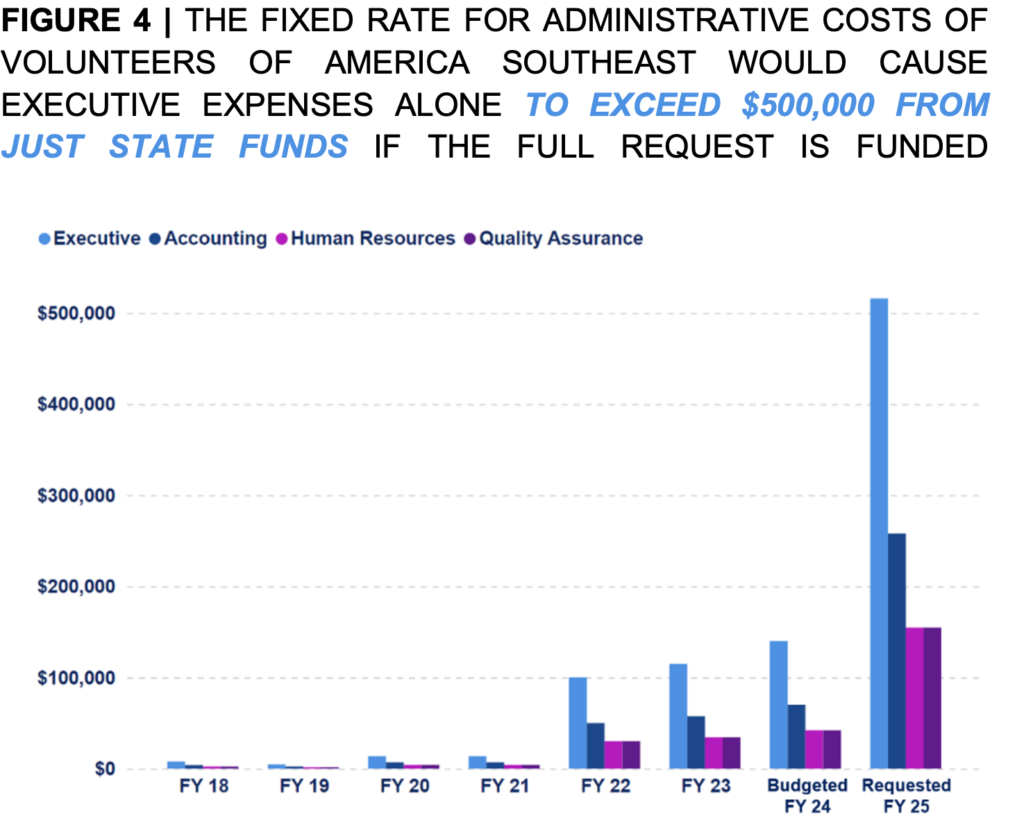

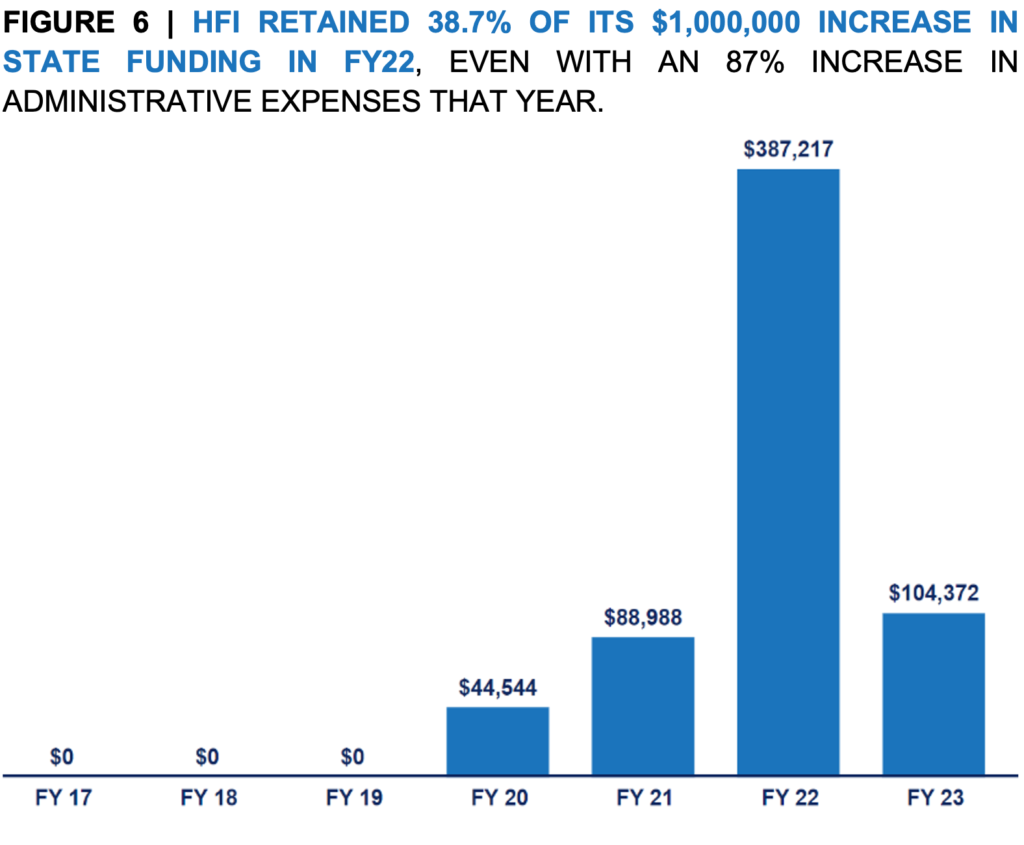 The State Support Team indicates that the majority of these surplus funds (68%) are budgeted to hire and train new case officers in the event HFI receives its full FY25 funding request.[xi] Not using these funds to provide training and resources to existing Local Units in need demonstrates an overall lack of efficiency.
The State Support Team indicates that the majority of these surplus funds (68%) are budgeted to hire and train new case officers in the event HFI receives its full FY25 funding request.[xi] Not using these funds to provide training and resources to existing Local Units in need demonstrates an overall lack of efficiency.
Accountability through the Lens of Efficiency The State Support Team has never requested Local Units’ financial information prior to this evaluation. Even during this evaluation, the State Support Team was unable to get complete financial information from two units for various reasons. This lack of oversight contributes to an overall poor understanding of local needs. Without this understanding, the state’s resources are not being used efficiently.
Recommendations
To ensure state resources are being used efficiently, create a more equitable, efficient, and accountable distribution of funds. The Helping Families Initiative should:- Cap circuit funding at the base amount until a targeted funding model is created.
- Create a targeted funding model that considers:
- Historical case load.
- Students enrolled in participating school systems.
- Number of Local Unit employees (FTEs).
- Capacity and availability for local investment.
- Require monthly itemized invoicing that includes all HFI related expenditures, regardless of revenue source.
- Set a startup funding amount where additional funding is not provided until Local Units have invoiced HFI for the full startup amount.
Conclusion
The Helping Families Initiative was designed by linking common practices rooted in research that are intended to address chronic absenteeism and behavior in school. The State Support Team’s efforts have been focused on expanding to new circuits rather than building efficient and effective programs that meet the HFI design within existing circuits. The lack of accountability and control over existing operations prevents HFI’s ability to determine impact on intended outcomes. Efforts should be made to correct these deficiencies prior to further expansion and to develop a plan to evaluate the program’s effect on these stated outcomes.Data & Methodologies
Interviews
ACES staff conducted interviews with the State Support Team to understand the program’s structure and conceptualize next steps for gathering data and information. Fidelity of the program was measured through a series of surveys and virtual interviews with each of the 17 operating Local Units.
ACES also conducted virtual interviews with participating school systems to understand their role in HFI. A representative sample of 16 participating school systems was created by separating school systems into quintiles based on student enrollment, chronic absenteeism, poverty, academic achievement, and demographics. Though all participating school systems were contacted, only 13 interviews were conducted due to scheduling limitations.
Additionally, ACES contacted judicial circuits not currently participating in HFI. The school system quintiles were aggregated into circuits to create a representative sample of ten non-participating circuits. Ten district attorneys participated in the evaluation. These ten district attorneys did not reflect circuits with the first or fifth quintiles.
Financial Analysis
ACES conducted analysis of annual revenues and expenditures of the State Support Team and of Local Units. Financial documentation was incomplete or not provided as requested for two Local Units. Throughout the financial reviews, there were numerous discrepancies between the reported receipts from HFI by Local Units and the reported allocations of state funds by the State Support Team.
Determining HFI Participation
ACES requested a list of participating schools within each operating judicial circuit. The HFI provided list contained 43 school systems. At the conclusion of fieldwork, it was determined there were inaccuracies in the provided list. Instead, there are 44 school systems participating in HFI. There were three systems missing from the HFI list that were discovered during interviews and data collection. The list also included two systems who are not currently participating in the program.
Where HFI Operates
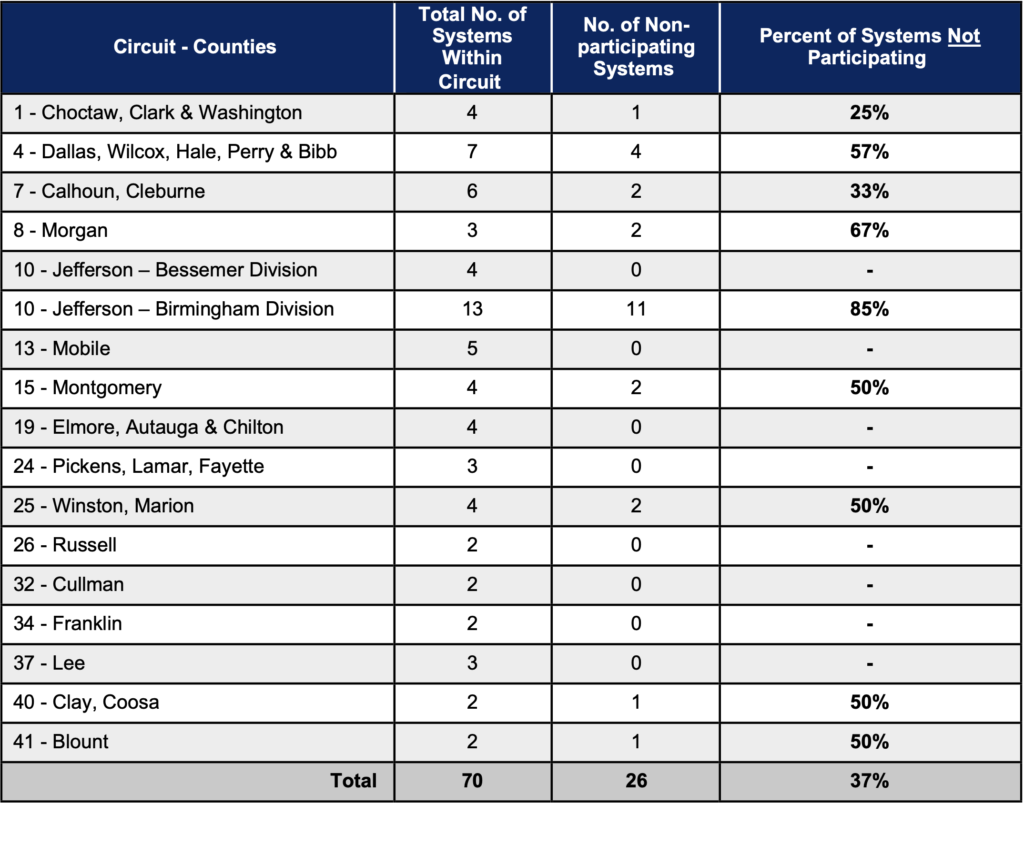
HFI Funding By Circuit
